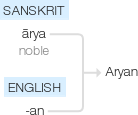Aryan
from Sanskrit ārya ‘noble’ + -an.
wiktionary
From Sanskrit आर्य(ā́rya, “noble; noble one”) + -n. The Sanskrit word is from Proto-Indo-Iranian *áryas (the original Indo-Iranian autonym). Borrowed into English in the 19th century, at first as a term for the Indo-Iranian languages, and later partly extended to the Indo-European languages and peoples following a theory by Friedrich Schlegel that connected the Indo-Iranian words arya/ā́rya with German Ehre(“honor”) and some older Germanic names, thus assuming that it was the original Indo-European autonym meaning "the honorable people". The original meaning of the Indo-Iranian autonym and its possible Indo-European origin/cognates are disputed (see the Wikipedia article for further details).
The same Proto-Indo-Iranian root is the ultimate source of the country name Iran.
etymonline
Aryan
c. 1600, as a term in classical history, from Latin Arianus, Ariana, from Greek Aria, Areia, names applied in classical times to the eastern part of ancient Persia and to its inhabitants. Ancient Persians used the name in reference to themselves (Old Persian ariya-), hence Iran. Ultimately from Sanskrit arya- "compatriot;" in later language "noble, of good family."
Also the name Sanskrit-speaking invaders of India gave themselves in the ancient texts. Thus it was the word early 19c. European philologists (Friedrich Schlegel, 1819, who linked it with German Ehre "honor") applied to the ancient people we now call Indo-Europeans, suspecting that this is what they called themselves. This use is attested in English from 1851. In German from 1845 it was specifically contrasted to Semitic (Lassen).
German philologist Max Müller (1823-1900) popularized Aryan in his writings on comparative linguistics, recommending it as the name (replacing Indo-European, Indo-Germanic, Caucasian, Japhetic) for the group of related, inflected languages connected with these peoples, mostly found in Europe but also including Sanskrit and Persian. The spelling Arian was used in this sense from 1839 (and is more philologically correct), but it caused confusion with Arian, the term in ecclesiastical history.
The terms for God, for house, for father, mother, son, daughter, for dog and cow, for heart and tears, for axe and tree, identical in all the Indo-European idioms, are like the watchwords of soldiers. We challenge the seeming stranger; and whether he answer with the lips of a Greek, a German, or an Indian, we recognize him as one of ourselves. [Müller, "History of Ancient Sanskrit Literature," 1859]
Aryan was gradually replaced in comparative linguistics c. 1900 by Indo-European, except when used to distinguish Indo-European languages of India from non-Indo-European ones. From the 1920s Aryan began to be used in Nazi ideology to mean "member of a Caucasian Gentile race of Nordic type." As an ethnic designation, however, it is properly limited to Indo-Iranians (most justly to the latter) and has fallen from general academic use since the Nazis adopted it.
